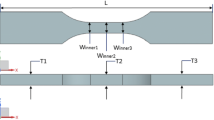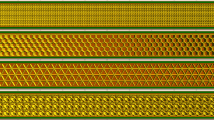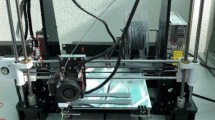Abstract
Additive manufacturing (AM) technology is capable of efficiently building complex shapes when compared with traditional manufacturing methods. Fused deposition modeling (FDM) is one of the AM processes, and it produces a great variety of polymeric parts. Therefore, it is essential to determine the relationship that exists among its process parameters, productivity and sustainability, quality of the final piece, and its structural performance. This paper presents an experimental study centered on optimizing five responses associated with FDM: energy consumption of the 3D printer, processing time, part's dimensional accuracy, the quantity of material used to print the pieces, and mechanical strength of the specimens. The model material employed was acrylonitrile styrene acrylate. The effects of five key process parameters on the responses were studied using the Taguchi methodology and analysis of variance (ANOVA). These parameters were layer thickness, filling pattern, orientation angle, printing plane, and position of the piece on the build platform. A desirability analysis was employed to determine the set of process parameters that provided the best trade-off among all the considered variables. The results showed that the approach presented in this work allowed for simultaneous optimization of all the observed variables for the 3D printing process.












Similar content being viewed by others
Data availability
The raw/processed data required to reproduce these findings cannot be shared at this time as data also form part of an ongoing study.
References
52900:2015, A (2015) Standard terminology for additive manufacturing–general principles–terminology. ASTM Int. https://doi.org/10.1520/F2792-12A.2
Alafaghani A, Qattawi A, Alrawi B, Guzman A (2017) Experimental optimization of fused deposition modelling processing parameters: a design-for-manufacturing approach. Procedia Manuf 10:791–803. https://doi.org/10.1016/j.promfg.2017.07.079
Alaimo G, Marconi S, Costato L, Auricchio F (2017) Influence of meso-structure and chemical composition on FDM 3D-printed parts. Compos B Eng 113:371–380. https://doi.org/10.1016/J.COMPOSITESB.2017.01.019
Al-Ghamdi KA (2019) Sustainable FDM additive manufacturing of ABS components with emphasis on energy minimized and time efficient lightweight construction. Int J Light Mater Manuf 2:338–345. https://doi.org/10.1016/j.ijlmm.2019.05.004
Chacón JM, Caminero MA, García-Plaza E, Núñez PJ (2017) Additive manufacturing of PLA structures using fused deposition modelling: effect of process parameters on mechanical properties and their optimal selection. Mater Des 124:143–157. https://doi.org/10.1016/j.matdes.2017.03.065
Chaudhari M, Jogi BF, Pawade RS (2018) Comparative study of part characteristics built using additive manufacturing (FDM). Procedia Manuf. https://doi.org/10.1016/j.promfg.2018.02.010
Conway KM, Pataky GJ (2019) Crazing in additively manufactured acrylonitrile butadiene styrene. Eng Fract Mech 211:114–124. https://doi.org/10.1016/J.ENGFRACMECH.2019.02.020
Fayazbakhsh K, Movahedi M, Kalman J (2019) The impact of defects on tensile properties of 3D printed parts manufactured by fused filament fabrication. Mater Today Commun 18:140–148. https://doi.org/10.1016/j.mtcomm.2018.12.003
Guessasma S, Belhabib S, Nouri H (2019) Microstructure, thermal and mechanical behavior of 3D printed acrylonitrile styrene acrylate. Macromol Mater Eng 304:1800793. https://doi.org/10.1002/mame.201800793
Hassanifard S, Hashemi SM (2020) On the strain-life fatigue parameters of additive manufactured plastic materials through fused filament fabrication process. Addit Manuf 32:100973. https://doi.org/10.1016/j.addma.2019.100973
Huynh HN, Nguyen AT, Ha NL, Ha Thai TT (2017) Application of fuzzy Taguchi method to improve the dimensional accuracy of fused deposition modeling processed product. In: Proceedings - 2017 International Conference on System Science and Engineering, ICSSE 2017. https://doi.org/10.1109/ICSSE.2017.8030847
Mohamed OA, Masood SH, Bhowmik JL (2016) Optimization of fused deposition modeling process parameters for dimensional accuracy using I-optimality criterion. Meas J Int Meas Confed 81:174–196. https://doi.org/10.1016/j.measurement.2015.12.011
Murr LE (2021) Rapid prototyping technologies: solid freedom fabrication, in: Handbook of materials structures, properties, processing and performance. Springer International Publishing, Cham, pp 1–13. https://doi.org/10.1007/978-3-319-01905-5_37-1
Padhi SK, Sahu RK, Mahapatra SS, Das HC, Sood AK, Patro B, Mondal AK (2017) Optimization of fused deposition modeling process parameters using a fuzzy inference system coupled with Taguchi philosophy. Adv Manuf 5:231–242. https://doi.org/10.1007/s40436-017-0187-4
Peng A, Xiao X, Yue R (2014) Process parameter optimization for fused deposition modeling using response surface methodology combined with fuzzy inference system. Int J Adv Manuf Technol 73:87–100. https://doi.org/10.1007/s00170-014-5796-5
Rashid A (2018) Additive manufacturing technologies. In: Chatti S, Tolio T (eds) CIRP encyclopedia of production engineering. Springer, Berlin, pp 1–9. https://doi.org/10.1007/978-3-642-35950-7_16866-1
Raut S, Jatti VS, Khedkar NK, Singh TP (2014) Investigation of the effect of built orientation on mechanical properties and total cost of FDM parts. Procedia Mater Sci 6:1625–1630. https://doi.org/10.1016/j.mspro.2014.07.146
Samykano M, Selvamani SK, Kadirgama K, Ngui WK, Kanagaraj G, Sudhakar K (2019) Mechanical property of FDM printed ABS: influence of printing parameters. Int J Adv Manuf Technol 102:2779–2796. https://doi.org/10.1007/s00170-019-03313-0
Singh R, Singh S, Singh IP, Fabbrocino F, Fraternali F (2017) Investigation for surface finish improvement of FDM parts by vapor smoothing process. Compos B Eng 111:228–234. https://doi.org/10.1016/j.compositesb.2016.11.062
Stratasys Ltd. (2019) ASA Data Sheet [WWW Document]. URL https://www.stratasys.com/materials/search/asa (accessed 10.31.19)
Sutherland JW, Gunter KL (2001) Environmental attributes of manufacturing processes. In: Handbook of environmentally conscious manufacturing. https://doi.org/10.1007/978-1-4615-1727-6_13
Tabacu S, Ducu C (2018) Experimental testing and numerical analysis of FDM multi-cell inserts and hybrid structures. Thin-Walled Struct 129:197–212. https://doi.org/10.1016/j.tws.2018.04.009
Tanoto YY, Anggono J, Siahaan IH, Budiman W (2017) The effect of orientation difference in fused deposition modeling of ABS polymer on the processing time, dimension accuracy, and strength. in: AIP Conference Proceedings. https://doi.org/10.1063/1.4968304
Verbeeten WMH, Lorenzo-Bañuelos M, Arribas-Subiñas PJ (2020) Anisotropic rate-dependent mechanical behavior of poly(lactic acid) processed by material extrusion additive manufacturing. Addit Manuf 31:100968. https://doi.org/10.1016/j.addma.2019.100968
Webbe Kerekes T, Lim H, Joe WY, Yun GJ (2019) Characterization of process–deformation/damage property relationship of fused deposition modeling (FDM) 3D-printed specimens. Addit Manuf 25:532–544. https://doi.org/10.1016/j.addma.2018.11.008
Zhao Y, Chen Y, Zhou Y (2019) Novel mechanical models of tensile strength and elastic property of FDM AM PLA materials: experimental and theoretical analyses. Mater Des 181:108089. https://doi.org/10.1016/j.matdes.2019.108089
Acknowledgments
The author would like to thank Tecnologico de Monterrey Campus Toluca for providing a 3D printer and material for conducting the experimental trials.
Author information
Authors and Affiliations
Corresponding author
Additional information
Publisher’s note
Springer Nature remains neutral with regard to jurisdictional claims in published maps and institutional affiliations.
Rights and permissions
About this article
Cite this article
Camposeco-Negrete, C. Optimization of printing parameters in fused deposition modeling for improving part quality and process sustainability. Int J Adv Manuf Technol 108, 2131–2147 (2020). https://doi.org/10.1007/s00170-020-05555-9
Received:
Accepted:
Published:
Issue Date:
DOI: https://doi.org/10.1007/s00170-020-05555-9




